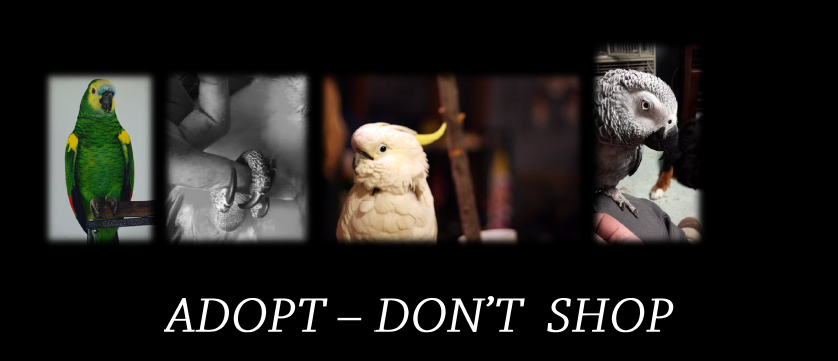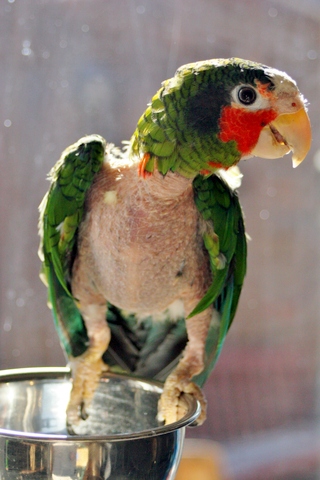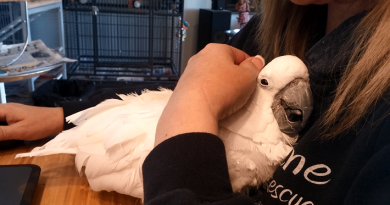My bird bit me – and I didn’t do anything wrong!
It’s a sunny afternoon, and you have just arrived home from work. You are excited to be home and play with your beloved parrot. You open his cage to let him out. You reach in for him to step up, and he bites your hand. HARD.
We have all been in this scenario with our companion birds. The biggest question we get asked is “What do you do when your bird bites you?!?”.
When your bird bites you, you gently put the bird down. You walk away and calm down. You administer first aid to your wounds. And you take a very close look at what the heck happened. The birds warning signs, the environment, your own actions, and the entire scenario need to be examined closely.

The truth is that you have been bitten, and it is already too late. You missed all the warning signs. You missed the fact that you burst in the door home from work, all excited (not calmly). You missed the fact that you rushed over to the cage in your excitement to play with your bird, who was happily napping and not really ready for a big playtime. You missed the fact that your bird used his body language to tell you he wasn’t ready to come out to play. He swayed from foot to foot. He puffed up his feathers. He pinned his eyes. He leaned away. And still you pushed, wanting to play with him. You pushed your hand into him. He had no other option left, he had to say “NO” in the only way he had left, with a bite. Then you left him alone.
This is the type of scenario we see every day. And with some guidance, you can see too. With the right eye, you can learn to see the warning signs and listen to the things your bird is saying, avoiding a bite altogether. You can set up the scenario to wait until your bird is ready to come out, and reward him for stepping gently onto your hand voluntarily.
What you DO NOT do when you are bitten is say “NO!” or “Bad Bird!”. You do not yell or scream. You do not tap the bird on the beak. You NEVER strike the bird in any way. You do not ‘earthquake’ or drop your hand. You never lock a bird in a cage in the dark. You never ‘ladder’ or continually ‘step up’ your bird. You put them down in a safe place, and walk away.
Some of the problems with the above mentioned ‘punishment’ techniques involve not listening to your bird. When you remove the choice from your bird, he must resort to ‘fight or flight’ instincts. This is a basic survival instinct. The bird learns that you never listen to any other warning, except biting. When you don’t listen it destroys any trust you have built between you. Other factors of your relationship will start to suffer. Your short term ‘gain’ is a long term issue for you both. Trust is often described as a bank account – you need to make more deposits than withdrawals. Building trust between yourself and your bird means listening to warning signs and giving the bird choice in their interactions with you.
Also, these ‘punishment’ techniques never teach your bird what TO do, only what NOT to do. There is a long list of things not to do in our house. Think more of what you would PREFER to see, what you WANT them to do and work towards that. I would prefer a bird to come forward in their cage to a specific perch, and lift one foot to indicate their willingness to come out to play. I can use positive reinforcement techniques to teach the bird how to do this willingly. It creates clear communication and builds trust between you.
In extreme situations a bird can be very fearful of something, like hands. Forcing the bird to endure the same fearful situation over and over again will never teach them to ‘get over it’. If you push an animal with this technique, there is the possibility they can shut down completely. It’s called flooding and can INCREASE fears and anxiety, and can caused increased aggression. This is not ‘learning to live with it’. It’s a large problem in companion parrots.
I’ve noticed over the years that caregivers do not want to harm their birds. But the use of punishment techniques is persistent. They have been either a) told somewhere that these techniques were the correct way to ‘discipline’ a bird b) are desperate and trying anything they can think of or c) have a lack of knowledge and skill in the use of force-free techniques in training. When given some guidance, all of the caregivers can learn to use the most effective and least intrusive techniques for behaviour modification.
Keep in mind that the behavior you’re worried about, is actually your parrot trying to express his needs. Something is wrong, and he’s trying to get you to make it right. Sometimes his ‘language’ needs interpretation (like body language), or maybe he’s learned the wrong way to ask for a nice thing (like ‘leave me alone please’). In the end, looking at the entire scenario from top to bottom will help you in the future. What set up the scenario? What happened? What did the bird gain from it? Once you have an idea of what really happened, you can calmly go back in the room with your parrot and try again. This time using your new tools, watching his body language, listening to your birds needs and using positive reinforcement techniques to reward the behavior you WANT to see. Your trust and future relationship together will be better for it.
Resources:
Dr. susan Friedman’s “the Facts about punishment”
http://www.thegabrielfoundation.org/pdffiles/punishment.pdf
Barbara Heidenreichs “Parrots and Punishment”
http://goodbirdinc.blogspot.ca/2008/04/parrots-and-punishment.html
Dr. Susan Friedmans “Alternatives to parrot breaking”
http://www.thegabrielfoundation.org/pdffiles/breaking.pdf
Steve martin “The Power of Trust”
http://naturalencounters.com/documents/ThePowerofTrust.pdf
Steve Martin “Height Dominance”
http://www.naturalencounters.com/images/Publications&Presentations/Height_Dominance-Steve_Martin.pdf
Stephanie Jackson “Biting and Dominance”
http://rationalparrot.com/biting.html




